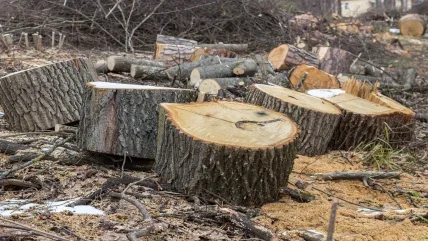
The Indian wood-based panels sector is steadily growing thanks to rapidly developing local economics and a stable demand for quality panels from local customers.
As the Chinese post-pandemic growth has significantly slow down and amid the economic isolation of Russia, India in recent months has become one of the world’s fastest growing emerging economies.
According to official data of the Indian Ministry of Economy, in the last quarter the country’s GDP grew by more than 7%, which contributed to the growth of the majority of industrial sectors of the country and primarily construction sector (+7%).
At present, the construction industry still remains the major consumer of wood-based panels in India, while its share in the overall structure of consumption is growing, already exceeding 80%.
The growth of the construction sector traditionally contributes to the growth of both panel production and their consumption in India.
MDF has been an investment area for the Indian boards market in recent years, accounting for the bulk of investments from major players. In recent years its growth rates have varied in the range of 18-23%, though it is to be noted that particleboard and hybrid products have been gaining momentum in Asia, generally due to it being more cost-effective and less energy intensive.
As the industry has achieved a significant growth of revenue in recent years it has been able to expand its capacities by installing some new modern equipment. Most of this equipment, along with machinery, has been supplied by global players, which have significantly strengthened their presence in the Indian market in recent years.
One such company is Andritz, which recently delivered its pressurised refining system at the MDF production plant in Punjab, which is operated by CenturyPly, a producer of plywood, MDF, particleboard and laminates.
The company placed another order for Andritz pressurised refining system for its MDF line in Andhra Pradesh. This will be the third system supplied by Andritz to CenturyPly. The new fibre preparation system will have a design capacity of 37 tons per hour and process eucalyptus and wood chips for producing high-quality MDF.
CenturyPly recently released its latest financial results, showing a pre-tax profit of €12.7m for the quarter ended June 30, 2023, compared to €14.7m in the same period a year ago.
Revenue for the period was €100m, virtually the same as a year ago.
Plywood remains the group’s biggest revenue generating area, followed by MDF, laminates and related products, then particleboard.
The plywood business segment made a pre-tax profit of €7.2m for the quarter ended June 30, compared to €4.3m for MDF and €958,000 for particleboard. It is to be noted that MDF profits fell from €6m in the same period a year before.
In the meantime, Greenpanel Industries Ltd, another major Indian MDF producer is also expanding its capacities by ordering a MAIER chipping line for an MDF plant to be installed in Routhusuramala, Andhra Pradesh from Dieffenbacher. Scheduled to begin operating in summer 2024, the Dieffenbacher MDF plant is the third ordered by Greenpanel.
The new chipping line is designed to process up to 60 tonnes of dry wood per hour. That became the same site where Greenpanel commissioned a Dieffenbacher MDF line with a 56m-long CPS, the longest continuous press in Asia, in 2018. The companies began their co-operation in 2010, with the first continuous wood-based panel plant on the subcontinent.
According to earlier statements, made by Shobhan Mittal, managing director and CEO of Greenpanel in an interview with Indian media, in recent years the company’s annual MDF production capacity has grown from 500,000m3 to 660,000m3.
The company, along with other major Indian players, hopes for stable growth this year. According to its spokesman, that will also be achieved due to more active automation of the sector and more active establishment of fully automated plants within the industry.
Greenpanel’s most recent quarter, ended June 30, 2023, saw MDF gross margins improved over the sequential quarter. Sales volumes were lower during the quarter (down 13% to due to maintenance shutdown of the Rudrapur plant for 19 days during April and profits were also affected by an increase in wood raw material costs).
It capacity utilisation was 74% in the quarter and the export element of production was down 25% on a year ago.
Almost the same position is shared by representatives of Greenply Industries, another major Indian MDF producer, which operates a new plant in Vadodara, with a capacity of approximately 800m3 per day.
Greenply Speciality Panels Private Ltd (formerly known as Baahu Panels Private Ltd), a wholly owned subsidiary, commenced commercial production of MDF at its unit situated at Sherpura, Vadodara, Gujarat on May 5, 2023.
The company hopes for approximately 40% utilisation in the full year 2024 and 60-70% in the full year 2025 for the plant. For the plant it ordered a Siempelkamp ContiRoll press that produces MDF and HDF with a board thickness variance ranging from 1.5mm to 35mm. On the raw materials front, most of it is accounted for by eucalyptus, which is one of the most common plantation tree species in India which is used for production of MDF/HDF board.
Overall, Uttarakhand, the Himalayan state in northern India, is becoming the biggest manufacturing hub for MDF production in the country due to planned commissioning of four high-capacity production lines with the capacity of 500m3 per day each with continuous lines. The list of these projects also includes those of Action Tesa, which plans to launch the fourth production line in the state of above 600m3 capacity per day, that will allow it to become the biggest producer of MDF in India.
At the same time CrossBond enterprise is also reportedly setting up a continuous line for MDF manufacturing in the state. The plant will cover a 25-acre site and the company will have an operational capacity of 550m3 per day of continuous press production.
INDIAN ECONOMY
The Covid-19 pandemic provided a major impetus for growth for many leading local players, leading to sky-rocketing demand for ready-made furniture in the Indian market.
For example, in the case of Greenpanel, this fuelled the company’s stock price, which grew by 26 times from May 2020 to April 2022.
Most local analysts predict bright prospects for the Indian board sector within the next several years. That will also be due to expected growth of the country’s furniture and housing sectors.
Currently, the Indian central government is continuing to undertake certain decisive measures to reduce the housing shortages in the country, which at present is estimated at about 50 million units.
In the next several years, there are plans to build more than 60 million houses across 205 cities in nine states of the country.
In addition, the growth of retail, hospitality and healthcare sectors have raised the demand for the commercial real estate. That will fuel the demand for panels in the local market.
According to Indian analysts in the field of boards and timber business, rapid urbanisation will also contribute to the further growth of the sector (with over 40% of the local population expected to be settled in urban areas by 2030). Many of those people would strive for a better standard of living as their per capita income increases, which will lead to the decline of the replacement cycle for furniture from the current 8-10 years to five to seven years.
Still, despite the existence of major players, the Indian panels market is characterised by the generally low level of consolidation and a high number of smaller players. As a rule, the quality of their products is significantly lower than those of the major players of the market.
In this regard, most analysts expect that the share of current market leaders will only continue to grow. Most of these companies are interested in the expansion of their co-operation with western partners for many of which the Indian market has become one of the biggest priority areas given their exodus from Russia and Ukraine – once important emerging markets for them.
The expansion of local production will also contribute to the decline of imports, which accounted for a significant share in the Indian panels market in the past.






